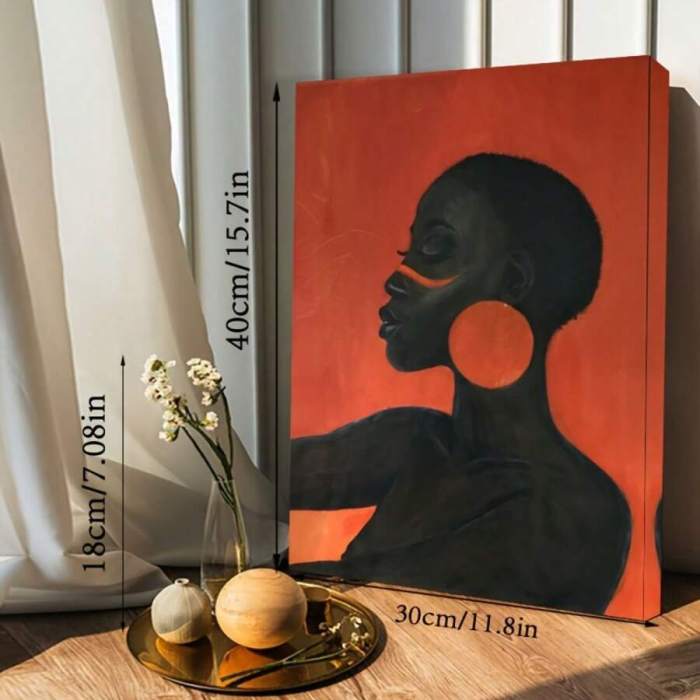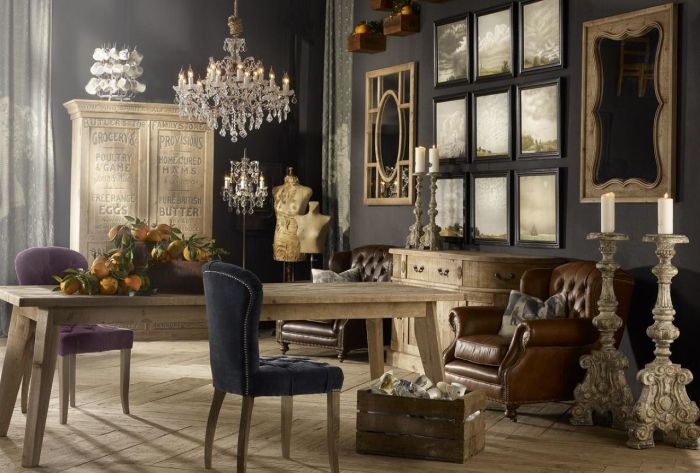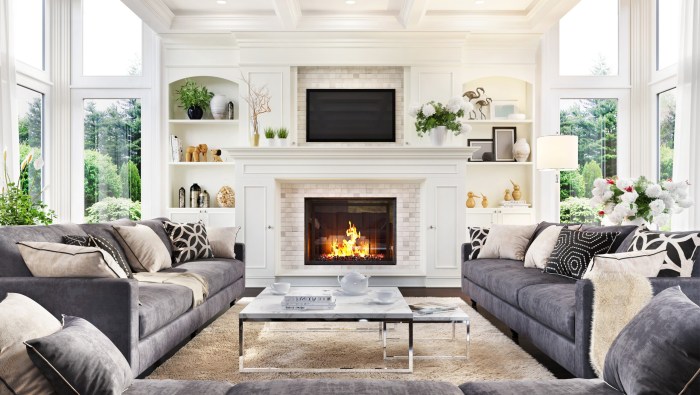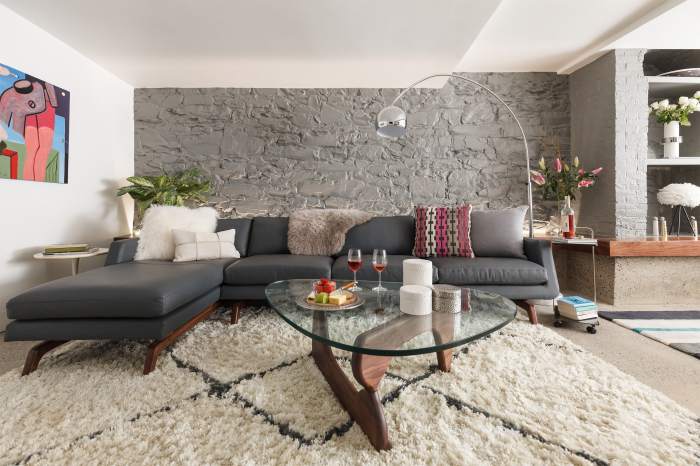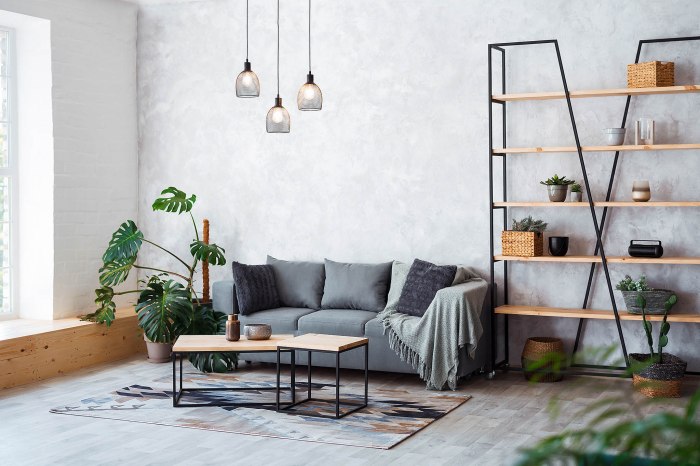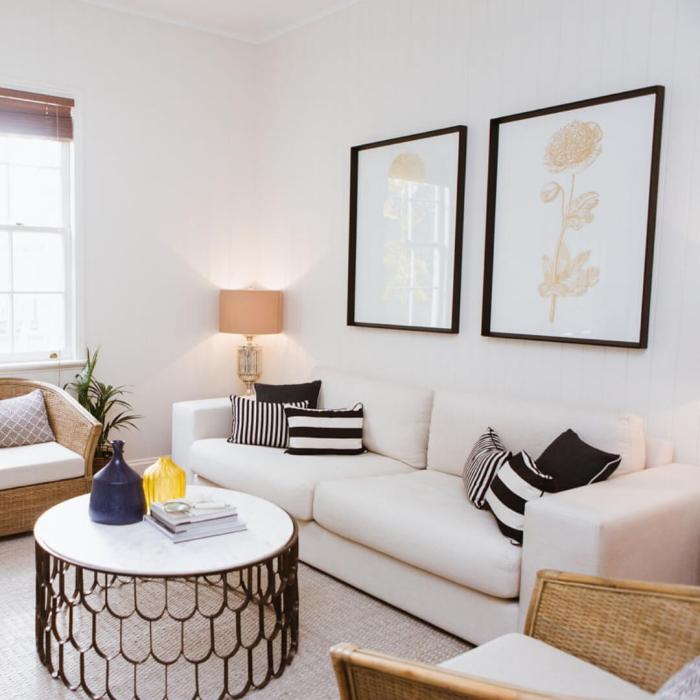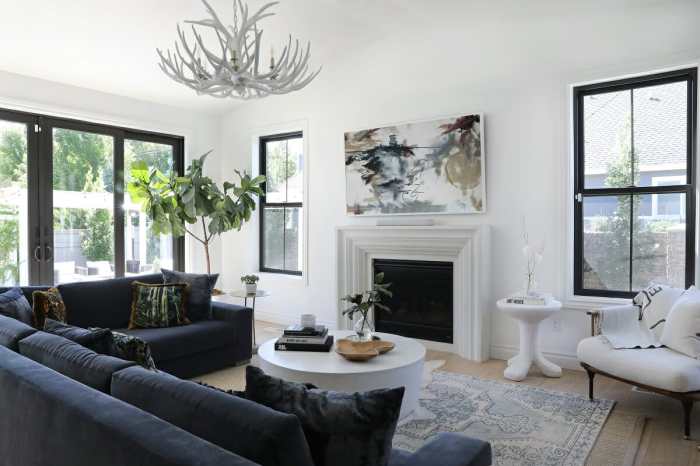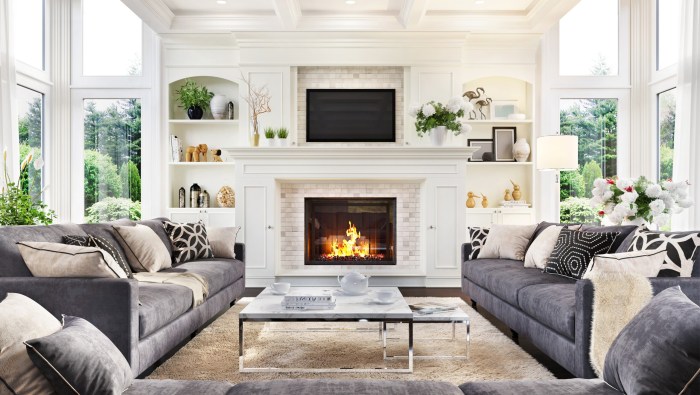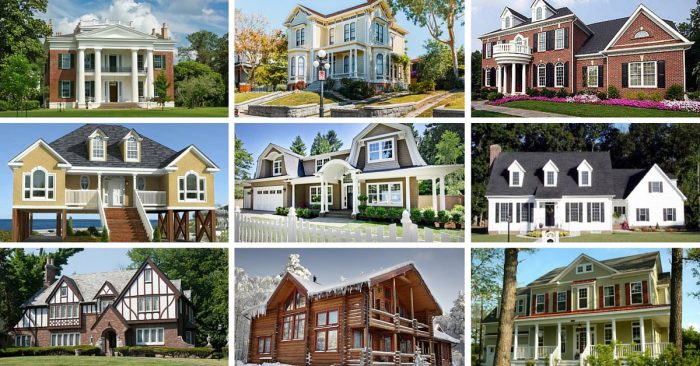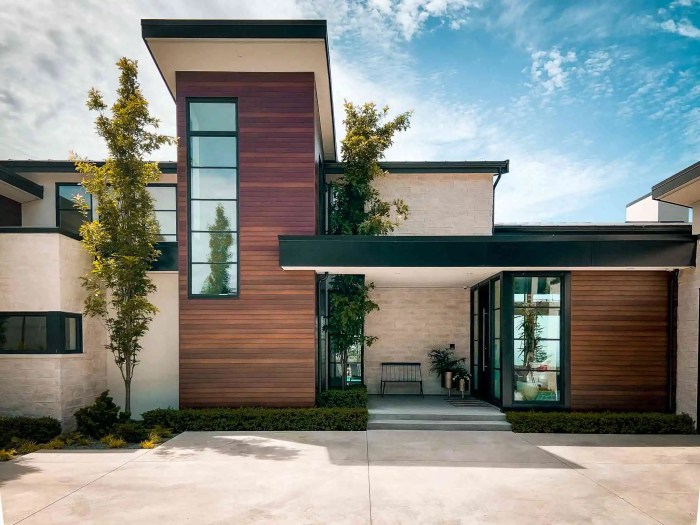Rustic home decor, a celebration of natural materials and unpretentious elegance, offers a sanctuary from the modern world. It evokes a sense of warmth, comfort, and connection to the earth, drawing inspiration from the simplicity of farmhouses, the ruggedness of cabins, and the grandeur of mountain lodges. This style transcends mere aesthetics; it’s a philosophy of design that prioritizes authenticity and handcrafted details, creating spaces that are both inviting and deeply personal.
From carefully curated color palettes to the strategic placement of natural elements, creating a rustic haven involves a thoughtful approach to every detail, transforming a house into a home imbued with character and charm.
This exploration delves into the core principles of rustic design, examining its defining characteristics, exploring diverse sub-styles, and providing practical guidance on furniture selection, color palettes, lighting schemes, and the incorporation of natural elements. We’ll navigate the nuances of creating a cohesive rustic aesthetic across various rooms, offering specific examples and design solutions to inspire your own unique rustic retreat.
The journey will highlight the importance of thoughtful material choices, the power of natural light, and the subtle art of accessorizing to achieve a truly authentic and captivating rustic ambiance.
Defining Rustic Style
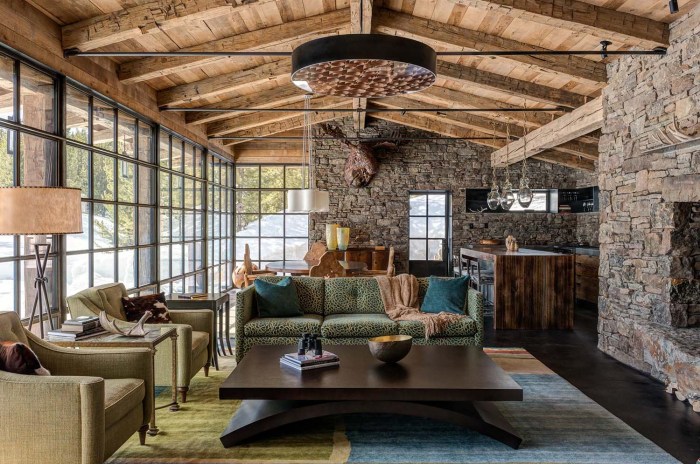
Rustic home decor evokes a sense of warmth, comfort, and connection to nature. It’s a style that celebrates the beauty of natural materials and handcrafted elements, often incorporating a sense of history and age. While seemingly simple, rustic design encompasses a variety of interpretations, each with its own unique characteristics and appeal.Rustic style is characterized by its use of natural, often reclaimed, materials.
The overall aesthetic aims for a feeling of relaxed elegance, avoiding overly polished or pristine appearances. Instead, imperfections are embraced, reflecting a sense of authenticity and history. The color palettes typically feature earthy tones – browns, greens, creams, and muted grays – often complemented by pops of bolder color in textiles and accessories. Key elements include exposed beams, stone fireplaces, wooden furniture, and natural fiber textiles.
Rustic Sub-Styles
Several distinct sub-styles fall under the broader umbrella of rustic decor. Understanding these nuances allows for a more tailored and personalized approach to interior design. These sub-styles borrow elements from specific historical periods, geographical locations, and cultural traditions, leading to distinct visual identities.
Farmhouse Rustic
Farmhouse rustic emphasizes simplicity and functionality. Think whitewashed walls, distressed wooden furniture, vintage finds, and floral patterns. The aesthetic often incorporates elements of Shaker design, characterized by its clean lines and minimalist approach. A farmhouse kitchen might feature a large, worn wooden table, open shelving displaying vintage crockery, and a cast iron sink. The overall feeling is one of comfortable practicality, reflecting the historical function of a farmhouse as a working space.
Cabin Rustic
Cabin rustic leans towards a more rugged and outdoorsy aesthetic. Think dark wood paneling, exposed stonework, animal hides, and antler accents. The color palette is often darker and more saturated than in farmhouse rustic, incorporating deep browns, greens, and even blacks. A cabin-style living room might feature a large stone fireplace, leather armchairs, and rustic wooden beams.
The overall effect is one of cozy warmth and rustic charm, evocative of a secluded mountain retreat.
Lodge Rustic
Lodge rustic shares similarities with cabin rustic, but tends to be more refined and luxurious. Think high-quality wood finishes, plush textiles, and elegant lighting fixtures. While still embracing natural materials, lodge rustic often incorporates more sophisticated details and a greater sense of opulence. A lodge-style bedroom might feature a king-size bed with a handcrafted wooden headboard, a plush wool rug, and elegant antler chandeliers.
The overall atmosphere is one of comfortable sophistication, reflecting a sense of refined rusticity.
Comparison with Other Styles
Rustic decor differs significantly from other interior design styles. Unlike minimalist styles which prioritize clean lines and empty spaces, rustic embraces texture, layering, and a sense of lived-in comfort. Compared to modern styles that emphasize sleekness and functionality, rustic prioritizes warmth and a connection to nature. While transitional styles blend elements of traditional and modern aesthetics, rustic maintains a strong emphasis on natural materials and a sense of history.
The Use of Natural Materials
The defining characteristic of rustic decor is its extensive use of natural materials. Wood, stone, and metal are fundamental elements, often employed in their raw or minimally processed forms. The choice of materials is not merely aesthetic; it contributes to the overall atmosphere of warmth, authenticity, and connection to nature. Reclaimed wood, for instance, adds character and history, its imperfections telling a story of time and use.
Stone fireplaces and countertops bring a sense of solidity and permanence, while metal accents – such as wrought iron – add visual interest and durability. The tactile qualities of these materials are also crucial, inviting touch and interaction, contributing to the overall sensory experience of the space.
Color Palettes for Rustic Homes
The psychology of color significantly impacts the atmosphere of a home. In rustic design, where the goal is to evoke feelings of warmth, comfort, and connection to nature, the chosen color palette plays a crucial role. Understanding the effects of different hues and their combinations is key to achieving a truly authentic and inviting rustic aesthetic. This section will explore three distinct color palettes ideal for rustic interiors, detailing their application in various rooms and the subtle yet powerful ways they contribute to the overall rustic ambiance.
Rustic Warmth: Earthy Browns and Creams
This palette centers around the natural tones found in the earth and aged wood. Deep browns, reminiscent of aged timber and rich soil, form the base. These are softened and brightened with creamy whites and off-whites, evoking the feel of sun-bleached linen or aged plaster. Accents of warm, muted yellows, like those found in dried grasses or autumn leaves, add depth and visual interest.In a living room, imagine walls painted in a warm, sandy beige, complemented by dark brown wooden beams across the ceiling.
A cream-colored sofa, perhaps with linen upholstery, anchors the space, while throw pillows in various shades of brown and muted yellow add texture and visual appeal. A dark brown wooden coffee table, possibly with a distressed finish, further reinforces the rustic theme. In a bedroom, the same color scheme can create a calming and inviting atmosphere. Think cream-colored walls, dark brown wooden furniture, and subtle yellow accents in the bedding or artwork.The impact of this palette lies in its ability to create a sense of grounding and stability.
The earthy browns promote feelings of security and connection to nature, while the creams add a touch of lightness and prevent the space from feeling too heavy or dark. The use of muted yellows adds a touch of warmth and vibrancy without disrupting the overall sense of calm.
Rustic Charm: Blues and Greys with Whitewashed Accents
This palette draws inspiration from the colors of the natural landscape, particularly the sky and weathered stone. Soft blues, reminiscent of a clear summer sky, are balanced by cool greys, reflecting the color of aged stone or weathered wood. Whitewashed accents, suggesting the look of aged wood or whitewashed brick, add brightness and prevent the space from feeling too somber.Consider a kitchen with whitewashed cabinets, complemented by grey countertops and blue-grey backsplash tiles.
The walls could be painted a pale grey or a soft blue, creating a serene and airy atmosphere. Wooden accents, perhaps in a light grey-washed finish, could be incorporated through the flooring or shelving. In a bathroom, a similar palette can create a spa-like atmosphere. Think whitewashed walls, grey tiles, and blue accents in the towels or accessories.This palette’s effectiveness lies in its ability to create a sense of tranquility and spaciousness.
The cool blues and greys are calming and refreshing, while the whitewashed accents add brightness and prevent the space from feeling too cold or sterile. This combination evokes a sense of serenity and understated elegance.
Rustic Modern: Deep Greens and Charcoal with pops of Metallics
This palette blends rustic elements with a touch of modern sophistication. Deep greens, inspired by lush forests and verdant landscapes, are combined with charcoal greys, representing the strength and resilience of stone. Metallic accents, such as copper or bronze, add a touch of luxury and visual interest.A dining room could feature charcoal grey walls, a large wooden dining table with a dark stain, and deep green velvet chairs.
Copper pendant lights above the table would add a touch of warmth and elegance. Artwork featuring natural landscapes or abstract designs in deep green and charcoal could further enhance the theme. In a home office, this palette can create a sophisticated and productive environment. Imagine a deep green desk, charcoal grey walls, and copper desk accessories.The impact of this palette comes from its ability to create a space that is both rustic and modern.
The deep greens and charcoals evoke a sense of sophistication and grounding, while the metallic accents add a touch of glamour and prevent the space from feeling too stark or somber. The juxtaposition of natural and metallic elements creates a unique and visually appealing aesthetic.
Furniture Selection for Rustic Decor
Choosing the right furniture is paramount in establishing the authentic ambiance of a rustic home. The pieces selected should not only be aesthetically pleasing but also reflect the durability and craftsmanship associated with rustic design, echoing the simplicity and functionality of historical rural living. The materials, proportions, and arrangement all contribute to creating a space that feels both welcoming and inherently connected to nature.
Essential Furniture Pieces for a Rustic Living Room
A rustic living room should prioritize comfort and functionality. The key is to select pieces that contribute to a relaxed and inviting atmosphere, reflecting the casual elegance of the style. Overly ornate or modern pieces will clash with the overall aesthetic.
- A substantial sofa, ideally upholstered in a durable fabric like linen or leather, offering ample seating for relaxation and conversation. Visualize a deep, plush sofa in a warm neutral tone, perhaps with subtly textured fabric, suggesting comfort and longevity.
- A coffee table made from reclaimed wood, featuring a natural, possibly distressed finish, to serve as a central gathering point. Imagine a large, low coffee table with a slightly uneven surface, hinting at its history and rustic charm.
- Two armchairs, mirroring the style of the sofa in terms of material and color palette, positioned to encourage conversation and comfortable lounging. Picture two sturdy armchairs, perhaps in a slightly lighter shade of the sofa fabric, creating a balanced and cohesive look.
- A rustic side table, crafted from wood or stone, to provide a surface for lamps, books, or other decorative items. Imagine a small, square side table made from rough-hewn wood, showcasing the natural grain and texture.
- A large area rug, ideally made from natural fibers like wool or jute, to add warmth and texture to the floor. Picture a rug with a simple, perhaps slightly faded pattern, adding a layer of comfort and visual interest to the space.
Suitable Materials for Rustic Furniture
The choice of materials significantly impacts the overall feel of rustic furniture. Natural, durable materials are preferred, echoing the connection to the natural world that defines the style.
- Wood Types: Reclaimed wood, such as barn wood or old-growth timber, is highly prized for its character and unique markings. Other suitable options include oak, pine, and walnut, often left with a natural or minimally processed finish to showcase the wood grain. The inherent variations in color and texture contribute to the rustic charm. For example, the knots and imperfections in reclaimed barn wood tell a story, adding to the piece’s unique character.
- Upholstery: Durable fabrics such as linen, cotton, and leather are ideal choices for upholstery. These materials age gracefully and develop a patina over time, adding to the rustic aesthetic. The textures and colors should complement the overall color palette of the room, maintaining a sense of harmony and cohesion. Think of a deep brown leather armchair, its surface subtly worn with age, showcasing the character of the material and the passage of time.
Importance of Furniture Size and Proportion in Rustic Spaces
Maintaining appropriate proportions is crucial in rustic design. Overly large or small furniture can disrupt the balance and harmony of the space.
Rustic spaces often feature high ceilings and open floor plans. Therefore, choosing furniture that is appropriately scaled to the room is essential to prevent the space from feeling cramped or disproportionate. For example, a large, oversized sofa in a small room would overwhelm the space, whereas a petite sofa in a large room would look lost and insignificant.
The furniture should complement the architecture of the space, creating a sense of balance and proportion. The goal is to achieve a harmonious relationship between the furniture and the overall architectural elements of the room.
Furniture Arrangement Ideas for a Rustic Dining Area
The dining area is a central social space in a rustic home. Furniture arrangement should encourage conversation and create a warm, inviting atmosphere.
A large, rectangular or round dining table made from reclaimed wood is a focal point. The size should accommodate all diners comfortably, allowing for easy movement and conversation. Surrounding the table with comfortable chairs or benches made from wood or upholstered in durable fabric completes the look. Consider a rustic sideboard or buffet for additional storage and display.
The arrangement should prioritize easy access to the table and create a flow that encourages interaction among the diners. For instance, a large round table encourages conversation and a sense of community, whereas a rectangular table might be better suited for a more formal dining experience. The overall arrangement should be conducive to the desired ambiance and the practical needs of the space.
Incorporating Natural Elements
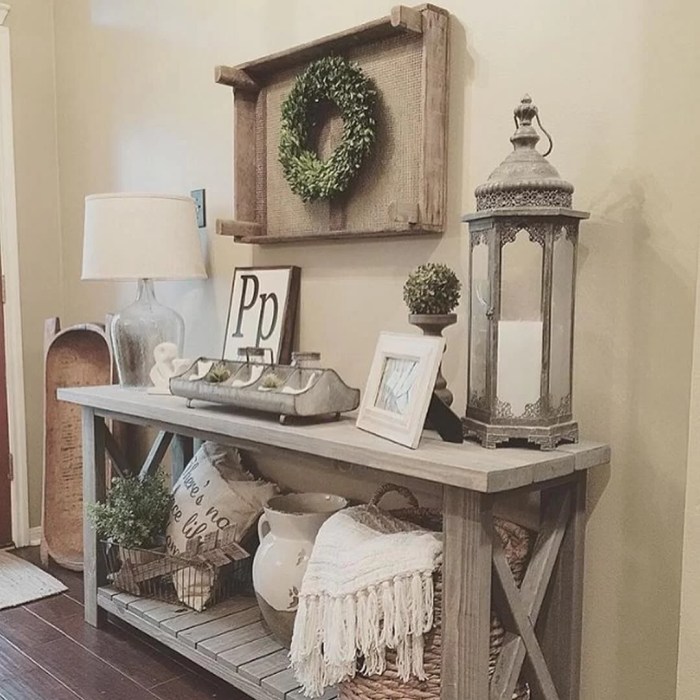
The inherent beauty of rustic decor lies in its connection to nature. Successfully integrating natural elements isn’t merely about aesthetics; it’s about creating a space that feels grounded, calming, and authentically reflects the surrounding environment. The tactile qualities of natural materials, their inherent variations in color and texture, contribute significantly to the overall ambiance, offering a sensory experience beyond visual appeal.
This section explores effective strategies for incorporating natural textures and materials, transforming a house into a home that resonates with the spirit of the outdoors.
Natural Texture Integration: Wood, Stone, and Leather
The use of wood, stone, and leather—materials deeply rooted in rustic aesthetics—introduces warmth, durability, and a sense of timelessness. Wood, with its varied grain patterns and inherent strength, provides a foundational element. The density and hardness of different wood species, such as oak or pine, dictate their suitability for various applications. Oak, known for its strength and durability, is ideal for flooring or heavy furniture.
Lighter woods like pine offer a more delicate aesthetic, perfect for shelving or accent pieces. Stone, whether rough-hewn or smoothly polished, brings a sense of permanence and solidity. Its inherent thermal mass can even contribute to temperature regulation within the home. The inclusion of leather, a material that ages gracefully, adds a touch of luxury and tactile richness.
Its durability and inherent texture add depth and visual interest. Consider leather upholstery for seating, or leather-bound books as decorative elements.
Rustic Centerpiece Design Using Natural Materials
A visually striking and conceptually impactful centerpiece can be created using readily available natural materials. Imagine a low, wide wooden bowl—perhaps reclaimed from an old barrel—filled with a carefully arranged collection of natural elements. The base of the bowl could be accented with a bed of moss, providing a soft, verdant foundation. On top, arrange pinecones of varying sizes, creating a sense of visual rhythm and texture.
Intersperse these with smooth river stones, adding a cool contrast to the warmth of the wood and the organic forms of the pinecones. Finally, incorporate a few sprigs of dried wildflowers or grasses for a touch of subtle color and delicate movement. This centerpiece is not only visually appealing but also embodies the core principles of rustic design—simplicity, natural beauty, and a sense of handcrafted authenticity.
The arrangement should emphasize asymmetry and a natural, rather than perfectly symmetrical, aesthetic.
Plant Integration for Rustic Ambiance Enhancement
Plants play a crucial role in enhancing the rustic atmosphere. Strategically placed potted plants, particularly those with a slightly wild or untamed appearance, can bring life and vibrancy to a room. Consider incorporating trailing plants like pothos or ivy, which can be placed on shelves or hung from beams to create a sense of lushness. Potted herbs, such as rosemary or thyme, not only add visual interest but also offer a delightful fragrance.
For larger spaces, consider a strategically placed potted tree, such as a fiddle-leaf fig or a small olive tree. The texture and form of the plant, the color of its foliage, and the shape of its pot are all crucial elements to consider when integrating plants into a rustic design scheme. The choice of pots should also complement the overall rustic theme; terracotta or woven baskets are excellent choices.
Reclaimed Wood Utilization in Rustic Decor
Reclaimed wood offers a unique blend of sustainability and aesthetic appeal. The history embedded within each piece adds character and depth to the design. Its varied textures, natural imperfections, and the marks of time create a narrative that speaks to the enduring beauty of natural materials. Reclaimed wood can be utilized in various ways: as flooring, wall paneling, furniture, or even as decorative elements such as shelves or picture frames.
The process of reclaiming wood often involves careful restoration and cleaning, ensuring its longevity and structural integrity. The use of reclaimed wood not only adds a unique aesthetic to a space but also promotes environmentally conscious design practices. Using reclaimed wood also reduces the demand for newly harvested timber, thus contributing to forest conservation efforts.
Lighting in Rustic Interiors
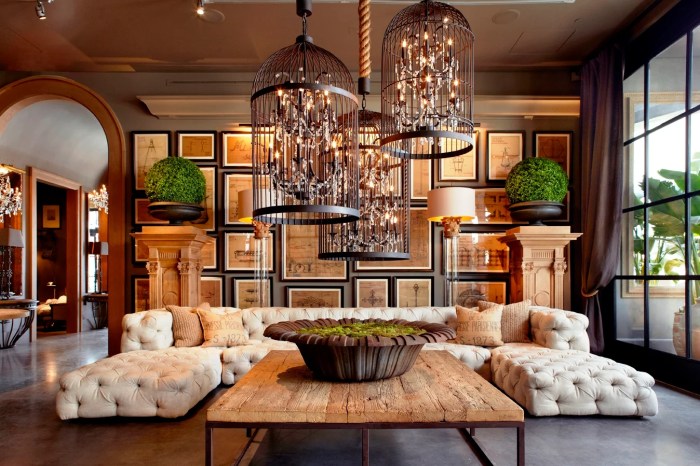
The careful orchestration of light is paramount in achieving the authentic warmth and inviting atmosphere of a rustic home. Lighting design isn’t merely about illumination; it’s about layering light sources to create depth, texture, and a sense of lived-in comfort, reflecting the historical context and handcrafted nature of the style. A well-designed lighting scheme enhances the natural materials and handcrafted details, transforming a space from merely functional to genuinely welcoming.
Rustic Bedroom Lighting Scheme: A Layered Approach
A successful rustic bedroom lighting scheme incorporates three key types of lighting: ambient, task, and accent. Ambient lighting provides overall illumination, setting the mood. Task lighting focuses light on specific areas for activities like reading or getting ready. Accent lighting highlights architectural features or decorative elements, adding visual interest. Consider a combination of these three types to create a balanced and functional lighting plan that supports the activities and aesthetic of the room.
For instance, a central pendant light might serve as ambient lighting, bedside lamps as task lighting, and strategically placed sconces as accent lighting.
Examples of Rustic Lighting Fixtures
Rustic lighting fixtures often employ natural materials and traditional designs. Materials such as wrought iron, reclaimed wood, and hand-blown glass are frequently used, reflecting the craftsmanship inherent in the style. For example, a wrought iron chandelier with exposed bulbs creates a dramatic focal point, while a simple wooden table lamp with a linen shade offers a softer, more intimate glow.
The style can range from simple and understated to elaborate and ornate, depending on the overall aesthetic of the space. Reclaimed wood, often showing signs of age and wear, can be incorporated into both pendant lights and wall sconces, adding a touch of history and character. Hand-blown glass shades, often with imperfections that enhance their rustic charm, provide a warm and inviting light.
Impact of Lighting on Rustic Ambiance
Lighting significantly impacts the overall ambiance of a rustic space. Warm-toned lighting, such as that emitted by incandescent bulbs or warm-white LED bulbs (around 2700K color temperature), contributes to the cozy and inviting atmosphere. Conversely, harsh, cool-toned lighting can disrupt the rustic feel, making the space appear sterile and modern. The color temperature of the light source directly influences the perceived mood; warmer tones evoke feelings of comfort and relaxation, while cooler tones can feel more energizing but less suited to the generally relaxed aesthetic of a rustic setting.
This effect is further amplified by the materials used in the fixtures; a rough-hewn wooden lampshade will diffuse light differently than a smooth, polished metal one, creating varied and nuanced lighting effects.
Utilizing Natural Light to Enhance Rustic Feel
Natural light is a crucial element in enhancing the rustic feel of a home. Maximizing natural light intake through large windows and skylights brings the outdoors in, highlighting the natural textures and materials within the space. This is particularly effective in bedrooms, where natural light promotes a sense of wellbeing and connection to the environment. Strategically placed mirrors can also be used to reflect and amplify natural light, creating a brighter and more spacious feel.
Incorporating sheer curtains or blinds allows for control over the amount of light entering the room while maintaining a sense of openness and connection to the outdoors. This approach further enhances the rustic aesthetic by allowing the natural light to highlight the natural materials and textures within the room, thereby creating a visually appealing and comfortable environment.
Rustic Decor Accessories
Rustic decor thrives on the thoughtful addition of accessories that enhance the overall aesthetic and tell a story. These items, often imbued with a sense of history and handcrafted charm, are not mere decorations but integral components of a successfully realized rustic design. Their careful selection and placement contribute significantly to the warmth and character of the space.
The strategic use of rustic accessories adds layers of visual interest and texture, transforming a house into a home that reflects the occupant’s personality and appreciation for natural materials and timeworn beauty. Understanding the function and visual impact of each accessory is crucial for achieving a cohesive and aesthetically pleasing rustic interior.
Rustic Accessory Selection and Function
The following list details ten common rustic home decor accessories and their respective roles in creating a rustic atmosphere. The selection considers both functionality and aesthetic contribution, highlighting the versatility of items often found in antique shops or crafted from natural materials.
- Wooden Bowls: These serve as attractive storage solutions for fruit, keys, or other small items, adding a tactile and visually appealing element to countertops or shelves. Their organic shapes and natural wood grain contribute to the overall rustic feel.
- Wicker Baskets: Highly functional for storage of blankets, magazines, or toys, wicker baskets offer a textural contrast and visual warmth. Their natural fibers complement the overall rustic aesthetic.
- Metal Lanterns: Providing both ambiance and practical illumination, metal lanterns, particularly those with a distressed or antique finish, create a sense of history and add a touch of romance.
- Stoneware Jars: These versatile containers can hold flowers, dried herbs, or kitchen utensils, adding a touch of rustic charm and practicality to any room.
- Antique Clocks: Beyond their time-telling function, antique clocks, especially those with visible gears or a distressed finish, add a sense of history and nostalgia to a rustic setting. Their intricate details are often a focal point.
- Wooden Trays: These serve as decorative and functional surfaces for displaying small objects, serving drinks, or organizing items on a coffee table or dresser. Their simple, natural design complements rustic aesthetics.
- Cast Iron Trivets: While primarily functional for protecting surfaces from hot cookware, cast iron trivets add a rustic industrial touch to a kitchen or dining area. Their weight and texture are striking visual elements.
- Vintage Books: Stacked on shelves or coffee tables, vintage books add a layer of visual interest and intellectual depth, suggesting a well-loved and lived-in space. Their aged covers contribute to the overall rustic charm.
- Woven Wall Hangings: These add visual texture and warmth to walls, often incorporating natural fibers like wool or cotton. Their patterns and colors can complement the overall color palette of the room.
- Pottery Vases: These add a touch of elegance and practicality, showcasing fresh or dried flowers. Hand-thrown pottery with irregular shapes and earthy tones is particularly well-suited to a rustic setting.
Effective Display of Rustic Accessories
The effective display of rustic accessories is crucial for creating a cohesive and inviting atmosphere. Overcrowding should be avoided, allowing each piece to breathe and contribute to the overall aesthetic. Grouping similar items together, such as a collection of stoneware jars or wooden bowls, creates visual interest and reinforces the rustic theme. Varying heights and textures prevents a monotonous look.
Consider using shelving units, mantelpieces, or coffee tables as platforms for displaying accessories. The strategic placement of items can draw the eye and create focal points within the room. For example, a collection of vintage books might be displayed on a rustic wooden shelf, while a group of metal lanterns could be arranged on a mantelpiece. The key is to create a balanced and visually appealing arrangement that enhances the overall rustic design.
Textiles in Rustic Settings
Textiles play a crucial role in softening the often hard lines and surfaces found in rustic decor. Rugs, throws, and curtains add warmth, texture, and visual interest. Natural fibers such as wool, cotton, and linen are ideal choices, reflecting the organic aesthetic of the style. Earthy tones and muted colors complement the overall rustic palette. Consider the texture and weave of the fabric; a chunky knit throw adds a cozy touch, while a finely woven rug can provide a sense of elegance.
For example, a large, hand-woven wool rug in a neutral tone can anchor a living room, while linen curtains in a warm beige or muted green can soften the windows. Throws draped over furniture add layers of texture and visual interest, while cushions in various textures and colors can add pops of color and comfort.
Rustic Mantelpiece Arrangement
The mantelpiece offers a prime opportunity to showcase rustic accessories and create a visual focal point. A well-curated arrangement balances visual weight and incorporates a variety of textures and heights. Begin with a foundational element, such as a large, rustic wooden tray or a mirror with a distressed frame. Then, add smaller items strategically, such as candles, lanterns, or small decorative objects.
Varying heights and textures creates visual interest, while maintaining a balanced and harmonious composition.
For example, a large, weathered wooden tray could serve as the base, with a collection of smaller items arranged on top: a vintage clock, a few small potted succulents, and a couple of candles in rustic holders. The addition of a long, woven garland could further enhance the visual appeal. The key is to avoid overcrowding, allowing each item to contribute to the overall aesthetic without overwhelming the space.
The goal is to create a visually appealing display that enhances the overall rustic aesthetic of the room, reflecting warmth and character.
Rustic Decor by Room
The application of rustic design principles extends beyond a singular aesthetic; it’s a holistic approach that transforms each room into a unique and inviting space. The key lies in understanding the inherent characteristics of each area and selecting materials and elements that enhance its functionality and ambiance. This involves careful consideration of factors such as light, traffic flow, and the intended use of the room.
The following examples illustrate how rustic elements can be seamlessly integrated into various spaces within a home.
Rustic Kitchen Design
The kitchen, often the heart of the home, presents a unique opportunity to showcase rustic style. The careful selection of cabinetry, countertops, and backsplash materials significantly impacts the overall aesthetic and functionality. The interplay of textures and colors creates a space that is both visually appealing and practical.
| Feature | Material | Style | Image Description |
|---|---|---|---|
| Cabinets | Reclaimed wood | Shaker | Dark stained wood cabinets with simple lines, showing natural wood grain. The wood displays a variety of tones and textures, indicative of its age and previous use, adding character and warmth. |
| Countertops | Butcher block | Rustic | Thick, worn butcher block countertop with visible knife marks. The rich color and textured surface tell a story of years of use, adding to its charm. The unevenness of the surface is a key characteristic of the rustic style. |
| Backsplash | Stone tile | Fieldstone | Irregularly shaped stone tiles in varying shades of grey and brown. The natural variations in color and texture create a visually interesting and organic backsplash. The rough, uneven edges mimic natural stone formations. |
| Lighting | Pendant lights | Industrial | Metal pendant lights with exposed bulbs. The exposed metal and simple design complement the rustic elements, creating a balanced and functional lighting solution. The bulbs themselves contribute to the industrial aesthetic. |
Rustic Bathroom Design
Transforming a bathroom into a rustic sanctuary involves a careful selection of fixtures and accessories that evoke a sense of natural warmth and tranquility. The use of natural materials, such as stone and wood, creates a spa-like atmosphere. This approach emphasizes functionality while maintaining the rustic aesthetic.Fixtures such as a pedestal sink crafted from reclaimed wood or a clawfoot bathtub add character and charm.
Accessories, such as woven baskets for storage and rough-hewn wooden shelves, further enhance the rustic ambiance. The integration of natural light through a large window or skylight enhances the feeling of spaciousness and connection with the outdoors. Earth-toned paint colors, such as sage green or warm beige, further complement the natural materials and create a calming environment.
A simple, yet elegant, mirror with a wooden frame completes the look.
Rustic Bedroom Design
The bedroom, a space for relaxation and rejuvenation, benefits from a rustic design that promotes tranquility and comfort. Textiles and furniture play a crucial role in establishing the desired atmosphere. The use of natural fibers, such as linen and cotton, contributes to a sense of calm and warmth.Furniture choices should emphasize simplicity and durability. A sturdy wooden bed frame, perhaps crafted from reclaimed wood, serves as a central element.
The incorporation of natural textures, such as a woven rug or a sheepskin throw, adds depth and visual interest. Soft lighting, provided by a simple bedside lamp with a linen shade, complements the overall rustic aesthetic. The color palette should consist of muted tones, such as beige, brown, and cream, to promote a restful environment. Careful consideration of layering textiles, from bedding to throws and curtains, creates a cozy and inviting space.
Ultimately, achieving a successful rustic home decor style is about more than simply replicating a specific aesthetic; it’s about crafting a space that reflects your personal style and creates a feeling of warmth and comfort. By understanding the fundamental principles of rustic design—the emphasis on natural materials, the use of earthy color palettes, and the strategic incorporation of texture and light—you can create a home that is both stylish and deeply personal.
Remember, the true beauty of rustic decor lies in its ability to blend seamlessly with your lifestyle, creating a haven where you can relax, rejuvenate, and connect with the simple pleasures of life. The journey of designing your rustic space is as rewarding as the finished product itself, a testament to the enduring appeal of nature-inspired design.
Detailed FAQs
What are some common mistakes to avoid when decorating in a rustic style?
Overdoing it with rustic elements can lead to a cluttered or kitschy look. Maintaining balance and avoiding excessive ornamentation is key. Also, neglecting proper lighting can diminish the warmth and ambiance of the space. Finally, failing to consider the overall scale and proportion of furniture can make a room feel cramped or unbalanced.
How can I incorporate rustic style into a modern home?
Blending rustic and modern elements creates a unique and sophisticated style. Introduce rustic textures like wood or stone through accent pieces like coffee tables or shelving units, while maintaining clean lines and minimalist furniture in other areas. A carefully chosen color palette that bridges both styles, like warm grays and muted greens, can help create a cohesive look.
Where can I find reclaimed wood for my rustic project?
Reclaimed wood can be sourced from various places, including salvage yards, demolition sites, and specialized lumber suppliers. Online marketplaces and antique shops can also be great resources. Always ensure the wood is properly treated and prepared for interior use.
How do I maintain the rustic look of wooden furniture?
Regular dusting and occasional cleaning with a slightly damp cloth is usually sufficient. For more significant cleaning, use wood-specific cleaning products and avoid harsh chemicals. Periodically applying a wood conditioner or sealant can help protect the wood and maintain its natural beauty.
Read More: Kanavino.org
